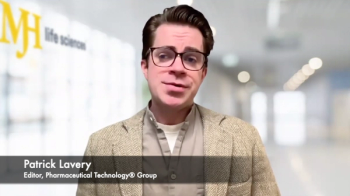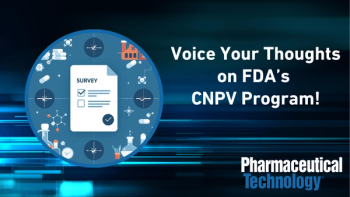
- Pharmaceutical Technology-04-02-2016
- Volume 40
- Issue 4
Ruggedness of Visible Residue Limits for Cleaning Validation
Visible residue limits have been shown to be a valuable tool in validated cleaning validation program.
Peer reviewed:
Submitted: July 31, 2015. Accepted: September 11, 2015.
AbstractVisible residue limits (VRLs) have been shown to be a valuable tool in a validated cleaning validation program. As an organization gains experience in establishing VRLs, the established levels generally go lower as personnel become more familiar with the appearance of visible residues and spike increasingly lower levels of residue to observe. These lower levels have led to a conundrum that requires an adjustment in the way VRLs are defined.
Visible residue limits (VRLs) can be quantitatively established for pharmaceutical products, APIs, excipients, and detergents (1-3). The VRL is the lowest level of residue that can be seen by a panel of observers under a defined set of observation parameters. If a VRL is lower than the calculated acceptable cleaning residue limit for a piece of equipment or an equipment train, then the VRL could be considered the cleaning limit for that equipment. The regulatory agencies have accepted the use of VRLs as a valuable tool to help develop, validate, and maintain a robust cleaning validation program (4, 5).
The ruggedness of VRLs has been established for different residues, personnel and viewing conditions (6), presentation of coupons for personnel observation (7), and for different materials of construction (MOCs) (8). Through all of these studies, the method of preparation of the VRL samples was held constant. A solution or suspension was prepared in a volatile solvent, typically methanol, serial dilutions were made to decreasing concentration levels and coupons were spiked by pipetting 100 µL onto the MOC coupon. The methanol spread out to a circle of about 5-cm diameter and rapidly evaporated, leaving a ring of visible residue.
There have been two primary outstanding concerns with this approach to establishing VRLs. The first concern was that a VRL established under defined viewing conditions might not be replicated in the field and that a practical VRL might be higher. Although this issue has been explored (9), it has not been definitively addressed and taking spiked coupons into the field or replicating VRL spike level on actual equipment is not practical on an ongoing basis, but it does warrant additional work.
The second concern was that the residues formed a ring and were not evenly distributed over the coupons. While it was acknowledged that the residues were not evenly distributed over the coupons, in the field, residues on cleaned equipment were more likely to show up as rings than as an even coverage on the equipment, especially at low residue levels. The entire area of the resulting circle was used in the calculation of the VRL (see Figure 1). This technique of determining VRLs was not an issue until experience and improved technique lowered the experimentally determined VRLs to levels that made them impractical. Alternative approaches to determining VRLs are proposed, which bring VRL levels back to a more practical level. The advantages and disadvantages of the various approaches were also compared to determine the most expeditious path forward.
Background
The initial work on VRLs (1) started with the 100-µg level with a target of 4 µg/cm2 to correlate with the level cited in the Fourman and Mullin article (10). Additional levels at decreasing values were also determined, but a true visual limit was not determined if the lowest level tested was visible and it was sufficiently lower than the acceptable cleaning residue limit (ARL) (i.e., at least two times lower or 50% of the ARL). The initial work surveyed a wide range of APIs, excipients, and formulations over a relatively short period of time to establish a complete database for a cleaning validation program in a clinical manufacturing facility. As applications of VRLs expanded (2) and experience grew, the spiking levels of the residues were lowered until a final set of spike levels were finalized, as shown in Table I.
The average of several hundred VRL determinations was 1.1 µg/cm2 (6), which made it a practical and achievable correlation to use the VRL as the ARL, although it was noted that roughly two-thirds of the VRLs were able to be seen at the lowest level spiked onto the coupons. There was a clear indication of the current situation. In addition, the average numbers were a little misleading in that as experience increased in determining the VRL levels, the numbers generated began to skew to lower levels (6). Now, when 1 µg of material is spiked onto a stainless steel coupon and allowed to spread out to a 5-cm diameter circle, it is often still visible under defined conditions of viewing distance, viewing angle, and light level. The area of the sample with a 5-cm diameter is 19.6 cm2 (π x (2.5cm)2), making the concentration of the sample 1 µg/20 cm2 or 0.05 µg/cm2. This would equate to a swab sample of 1.2 µg using a 25-cm2 swab area. Extracting the 1.2-µg sample into solvent for analysis results in a solution concentration well below 1.0 µg/mL.
An attempt was made (10) to incorporate VRLs along with swab and rinse recoveries and relative cleanability into an efficient, cohesive effort to generate relevant worst-case soils, ARL, and recovery factors into a short series of studies. It was understood that an ARL was calculated using an acceptable daily exposure (ADE) to assure patient safety and if the VRL was lower than the calculated ARL, then the VRL level was the de facto cleaning limit. All cleaning validation test samples should come back lower than the cleaning limit to validate a cleaning procedure.
Using a 1 µg/20 cm2 or 0.05 µg/cm2 VRL as a cleaning limit is not practical. VRLs established using this approach at this level could result in a practical quantitative contradiction between the VRL and the limit of quantitation/limit of detection (LOQ/LOD) of the analytical test method if the VRL is lower than the LOQ/LOD. Per regulatory guidance, the sensitivity of the analytical method should extend below the cleaning limit to assess the effectiveness of the cleaning procedure. This approach, however, is not possible if the visual limit is lower than the analytical limit. Even with a VRL at or near the quantitation limits of the analytical method, there would be a very narrow margin between the VRL level for a piece of equipment and the ability of the analytical test method to determine the residual analyte of interest.
As long as the VRL is above the LOQ/LOD of the analytical method, this approach to determining VRLs is acceptable. However, as personnel gain experience, the VRLs start trending to lower values and the analytical sensitivity will become an issue. Either an alternative, more practical quantitative approach is necessary, or VRLs generated using this approach can be treated as more qualitative with the assurance that the equipment will be visually soiled long before there is a concern for patient safety.
Methodology
There are several alternatives to the VRL methodology described in the first part of this article, both qualitative and quantitative. A second, qualitative alternative would be to spike residue at the ARL and at some level below the ARL (50% or 25%) using the same spiking procedure as described previously. If the residues are visually detected, then there would be confidence that the residue would be visible on equipment at levels lower than the ARL and, therefore, visual inspection would be appropriate to determine equipment cleanliness. The VRL would be listed as ‘less than’ the lowest residue level tested.
For this study, two additional alternative methods of determining practical, quantitative VRLs were explored. A third approach is to continue to prepare the residue samples in the same manner as described and measure the area of only the residue ring by subtracting the area of the inner circle from the larger circle leaving only the area covered by the residue as shown in Figures 2 and 3 using Equation 1:
[Eq. 1] Ring Area = πr2 – πr22 = π(r12 – r22) = π(r1 – r2) (r1 – r2)
For example, spiking 100 µL of a 10-µg/mL spiking solution results in a residue with an outer diameter of 5 cm and an inner diameter of 4.8 cm, the area of the residue is 1.5 cm2 compared to the area of the 5-cm circle alone, which is 19.6 cm2. For a 1-µg residue sample, this changes the concentration from 0.05 µg/cm2 to 0.67 µg/cm2. This would result in a swab sample of 17 µg using a 25-cm2 swab area.
A fourth approach, which should also be more quantitative, is to generate a residue with a uniform coverage. Because low spike levels such as 1 µg in 100 µL result in a ring residue at larger areas, minimizing the area of the residue can be accomplished by spiking a minimum volume of a higher concentration sample. Spiking 20 µL of a 75 µg/mL spiking solution resulted in a more uniform 1.5-µg residue. The resulting uniform residue spread over a circle with a diameter of 0.8 cm and an area of 0.5 cm2 and a concentration of 3 µg/cm2 or 75 µg/25 cm2.
Serial dilutions were made and similarly spiked. The additional samples are shown in Table II and Figure 4. It can be seen in Figure 4 that the first three spots are uniform while spots four and five are not uniformly distributed. The VRL can be determined using the lowest uniformly distributed residue from spot three for a VRL of 0.5 µg/cm2. Although spots four and five are visible, they are not uniformly distributed and attempting to determine a VRL would result in the same issue as with the Figure 1 determination (i.e., overestimating the area resulting in a lower VRL). This situation of the uniform and non-uniform residues is analogous to the LOQ and LOD of an analytical test method. The third spot can be quantitatively determined, but quantitation of spots four and five is not possible even though they are visible.
Discussion
Each of the four approaches for VRLs has its advantages as well as drawbacks. Table III provides a summary for the different approaches including preparation, level of VRL, and primary issue. Each is a reasonable approach as long as the company defines their process and is aware of the intent and limitations for the approach they have chosen.
The initial approach described in the background section of spiking a known quantity of residue in decreasing amounts onto multiple coupons and then measuring the area of the entire circular dried residue provides assurance that visible residue would be detected on the equipment surfaces well before the residue becomes a safety risk in the subsequent manufactured batch. This determination of a VRL provides a quantitative assessment of the “margin of safety” between the VRL level and the ARL of the spiked API or formulation. This approach serves as a much better training tool in that personnel will get a better impression of the appearance of the residues as they near the VRL, which is a valuable perspective to have, particularly for older cleaned equipment that is subject to other permanent marks on the surfaces. It is also practical in that residue will often appear as rings or water spots on cleaned, dried equipment.
The major potential drawback to this approach can be seen in Table I. If a 1-µg spiked sample is visible, which is often the case, it will have a resulting concentration of 0.05 µg/cm2. Swabbing this sample and extracting into 10 mL of solvent would result in a sample concentration of 0.1 µg/mL. If not already below the LOQ of the analytical method, it would be very near to it for most analytical testing technologies, including the commonly used technologies for testing cleaning samples, such as high performance liquid chromatography (HPLC) and total organic carbon (TOC) analysis. Because the VRL should be considered equivalent to the ARL, it is expected that the test method for cleaning samples should have an LOQ lower than the ARL for the residue. The analytical test method might not be adequately sensitive, or if it is sensitive enough, samples would be in danger of failing if anything is detected in the test.
This danger of a potential cleaning failure using this VRL approach is unjustified because the majority of the spiked, dried residue area is not occupied with residue. At these low spiked concentrations, a ring is formed and the residue occupies only a small area around the perimeter of the dried circle. Although this approach to determination of VRLs is efficient and provides an accurate determination of the amount of residue divided by the area of the residue, the residue is not a uniform residue and results in a VRL lower than is practical. A VRL determined this way can be misleading if an attempt is made to relate it to the LOQ of the analytical method. VRLs established using this approach, however, can certainly be compared to the ADE calculated cleaning limit to determine that visual inspection is adequate for cleaning confirmation; and to determine how wide the “margin of safety” is between the visual limit and the cleaning limit.
The simplest approach is the second one described previously, which is to spike coupons at a single level that is lower (e.g., 50%) than the ARL. If the spiked residue is visible, it provides assurance that visible residue would be detected on the equipment surfaces before the residue became a safety risk in the subsequent manufactured batch. This approach avoids the low level practicality issue and also has the advantage of speed in that samples can be prepared relatively quickly and calculations are not necessary. Fewer coupons would be used per residue, therefore, more residues could be qualified at the same time. This approach might be recommended if a company wished to establish a VRL program in an efficient time frame or quickly determine the limitations of detecting the visible residue using multiple distances and viewing angles. This approach would also be useful for training or qualifying a large group of personnel, such as all equipment washers and inspection personnel. This approach is also practical in that residue will most often appear as rings or water spots on cleaned, dried equipment.
The drawbacks with this approach are that it provides a qualitative determination only, while not well defining the “margin of safety” between the VRL and the ARL. A minor drawback is if the spiked residue is not visible, one cannot be certain that some level between the spiked level and the ARL might still be visible and additional coupons would have to be spiked until a visual residue is observed. The biggest drawback to a purely qualitative approach is that the visual limit should actually be the cleaning ARL if residue is visible at levels lower than the calculated cleaning ARL. However, if a company states in their strategy that they are looking at VRLs, solely from a qualitative perspective and that the lower spike level provides a level of confidence to ensure that visibly soiled equipment will not be deemed ‘clean,’ and uses the calculated ARLs as their cleaning limit, this should be a viable approach and defensible with the agencies.
The third approach is to use the same spiking technique as the first two approaches, but then measure only the ring area that is covered by the residue. There are several advantages with this strategy. The spiking of the coupons is straightforward, the residues appear as they would on cleaned and dried equipment, and most importantly, this approach results in a more realistic determination of a VRL because it includes only the area covered by the residue. The higher VRL determinations also should be well above an achievable LOQ and LOD for an analytical test method.
The primary drawback of this approach is the potential inconsistency of the ring thickness and the subsequent subjectivity for determination of the ring thickness. The inside edge of the ring might not be well defined and a somewhat subjective assessment will need to determine the measurement inner edge of the ring. The wider the ring, the lower the resulting concentration of the dried residue. This issue would need to be addressed in a protocol prior to generating official VRL data using this approach.
The objective of the fourth approach was to have a uniform residue rather than a ring type residue. Advantages to this approach include the more realistic VRL based only on area covered by the residue as well as the fact that because the smaller residues take up less space and therefore fewer coupons, more residue VRLs can be generated using fewer coupons.
Potential disadvantages with this approach include: pipetting very small volumes (20 µL) accurately and the concept of LOQ and LOD of visible residue. At some point, residue would still be visible but the concentration not able to be accurately determined.
Conclusion
Different approaches to establishing VRLs were proposed and discussed. Each of the four approaches is viable as long as it is spelled out in the overall cleaning validation master plan strategy and applied consistently. Two more accurately quantitative approaches were defined, which seem to be roughly equivalent in the resulting VRLs, but the practicality of each can only be better assessed through generation of data and a side-by-side comparison.
References
1. R. J. Forsyth, V. Van Nostrand, Pharm Technol, 28, 10 54-72 (2004).
2. R. J. Forsyth, V. Van Nostrand, Pharm Technol, 29, 10 152 -161 (2005).
3. R. J. Forsyth, Pharm Eng, 29, 1 22-34 (2009).
4. Health Canada, Cleaning Validation Guidelines (Guide-0028) (2008).
5. Pharmaceutical International Convention (PIC/S), Recommendation on Cleaning Validation (PI 006-3) (2007).
6. R. J. Forsyth, Pharm Technol, 33, 3 (2009) 102-111 (2009).
7. R. J. Forsyth, Pharm Technol, 35, 3 122-128 (2011).
8. R. J. Forsyth, K. Bader, K. Jordan, Pharm Technol, 37, 10 2-6 (2013).
9. K. Bader and K. Jordan, J. Val Technol, 20, 1 (2014).
10. G. L. Fourman and M. V. Mullen, Pharm. Technol.17 (4), 54-60 (1993).
Article Detailsâ¨
Pharmaceutical Technology
Vol. 40, No.4
Page: 50-57
Citation
When referring to this article, please cite it as J. Forsyth, “Ruggedness of Visible Residue Limits for Cleaning Validation," Pharmaceutical Technology 40 (4) 2016.
Articles in this issue
over 9 years ago
Understanding Measurement Uncertainty in Weighingover 9 years ago
Blister Pack Optimizationover 9 years ago
Technology Transfer Connectionsover 9 years ago
Requirements for Product Technology Transferover 9 years ago
Ensuring Quality in Solid and Semi-Solid Dosage Formsover 9 years ago
Conjugation Chemistry with Highly Potent Compoundsover 9 years ago
Failure Mode Effects Analysis for Filter Integrity Testingover 9 years ago
More Outsourcing? More Monitoring.over 9 years ago
Shipping: Proactive Risk Managementover 9 years ago
Container Selection for Biologic FormulationsNewsletter
Get the essential updates shaping the future of pharma manufacturing and compliance—subscribe today to Pharmaceutical Technology and never miss a breakthrough.





